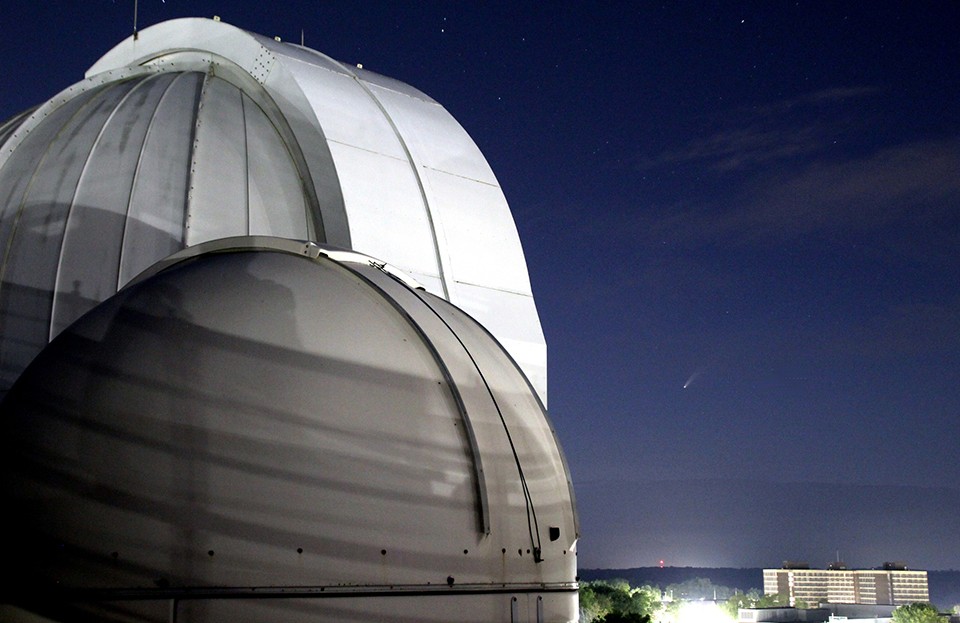Enjoy it now, or wait another 7,000 years: Eastern Michigan University astronomer Norbert Vance reports on his sightings of the comet NEOWISE

YPSILANTI – There will be a beautiful and rare show outside your door this week, with only a clear, unlit sky required for admission.
Eastern Michigan University astronomer Norbert Vance shared a variety of spectacular images of the Comet NEOWISE as it has come into view this month. Here are some questions and answers about his exciting sighting and how you can view the comet.
Question: Can we still see the comet this week?
Vance: As long as it's clear out, of course. The haze on these warm nights and lights of the city diminish the views, so folks are best served by getting out to the countryside with binoculars as it passes underneath the Big Dipper in the northwest evening sky during the next three days or so.
Question: How bright is the comet?
Vance: The comet is nowhere near as bright as Comet Hale-Bopp back in 1997, but this is a pretty and unexpectedly convenient comet now appearing in the evening sky. It’s worthy of anyone's attention. Darkness really starts to set in around 10:15 p.m. for the best views of the comet.
Question: What is the best way to find the comet in the sky?
Vance: Contrary to some curious notions, comets lollygag along over several weeks to months and don't zip across the sky like meteors. It's best to scan with binoculars first. Once located, you can peer up with the unaided eye and realize that's the comet you are seeing!
Question: How big is the comet?
Vance: It's a three-mile diameter hunk of ice/rock with a tail millions of miles long, pointing away from the Sun like a weathervane. Comets spend most of their time far beyond the orbit of Pluto out in the Ort Cloud. This one just paid us an unexpected visit to say hello.
Question: Can you say more about the comet’s path?
Vance: The comet reaches its closest distance to Earth on July 22, at 64 million miles while sweeping past, heading out to the deep cold of the outer solar system until returning in 6,950 years, give or take, from now.
Its trajectory carried it around the Sun, with its closest or perihelion point passed on July 3 at just inside Mercury's orbit and outside the plane of the planetary orbits. It passes up and over us on its way out, this visit increasing its orbital period by a few thousand years.
Question: Did you see the comet from the Eastern campus at the Sherzer Observatory?
Vance: Yes. Many of the recent Comet NEOWISE images have been taken from dark sites, from national parks or by guided instruments. I went to the bright lights of the EMU campus and snapped images of the comet from the roof of our observatory around 10:30 p.m.
The scale shown in the photos gives an idea of what the comet might look like through low power binoculars, even the naked eye if the skies weren't so bright. The camera does some magic. I fought off haze and pesky clouds, too. But remember, it won't return for about 6,950 years. You do not want to miss it and live a life of regret!
Question: Normally, during times without this pandemic, the public could come up there and observe, right?
Vance: Indeed, they could. It was strange to be up on the deck alone. Ordinarily, I would have a lot of people, students and public up there enjoying the views as well. Such is life these days.
About Eastern Michigan University
Founded in 1849, Eastern is the second oldest public university in Michigan. It currently serves nearly 18,000 students pursuing undergraduate, graduate, specialist, doctoral and certificate degrees in the arts, sciences and professions. In all, more than 300 majors, minors and concentrations are delivered through the University's Colleges of Arts and Sciences; Business; Education; Engineering and Technology; Health and Human Services; and, its graduate school. EMU is regularly recognized by national publications for its excellence, diversity, and commitment to applied education. For more information about Eastern Michigan University, visit the University's website.
More Stories
Eastern Michigan University Vice President for Enrollment Management Katie Condon-Martin to help shed light on FAFSA “fiasco” as part of Bridge Michigan Zoom discussion on April 24.

Eastern Michigan University awards Summer Research and Creative Activity Grants.

Eastern Michigan University to launch new Bachelor of Business Administration in Financial Planning and Wealth Management degree.

Eastern Michigan University empowers student-faculty collaboration with Undergraduate Symposium Research Fellow Awards.

Eastern Michigan University senior Raya Lasiewski inspires hope and healing through personal journey with eating disorder.

